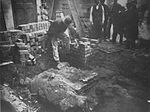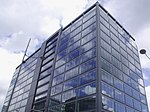Upper Priory Cotton Mill
The Upper Priory Cotton Mill, opened in Birmingham, England in the summer of 1741, was the world's first mechanised cotton-spinning factory or cotton mill. Established by Lewis Paul and John Wyatt in a former warehouse in the Upper Priory, near Paul's house in Old Square, it was the first of the Paul-Wyatt cotton mills that used the roller spinning machinery that they had developed and that had been patented by Paul in 1738, that for the first time enabled the spinning of cotton "without the aid of human fingers". Wyatt had realised that this machinery would enable several machines to be powered from a single source of power: foreseeing the development of the factory system, he envisaged "a kind of mill, with wheels turned either by horses, water or wind."
Excerpt from the Wikipedia article Upper Priory Cotton Mill (License: CC BY-SA 3.0, Authors).Upper Priory Cotton Mill
Old Square, Birmingham Digbeth
Geographical coordinates (GPS) Address Nearby Places Show on map
Geographical coordinates (GPS)
| Latitude | Longitude |
|---|---|
| N 52.4822 ° | E -1.8944 ° |
Address
Old Square
Old Square
Birmingham, Digbeth
England, United Kingdom
Open on Google Maps









